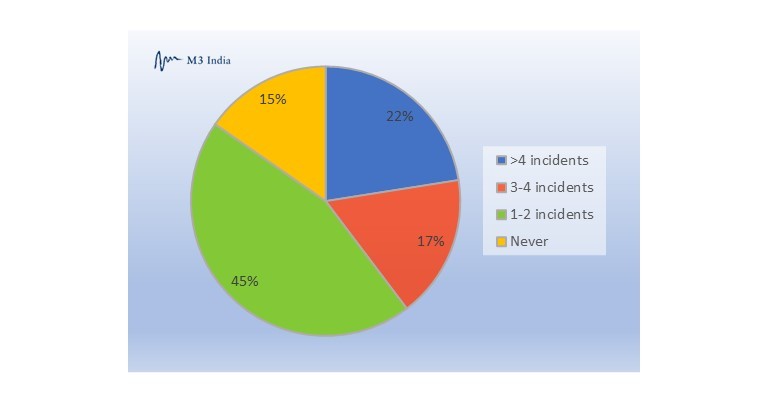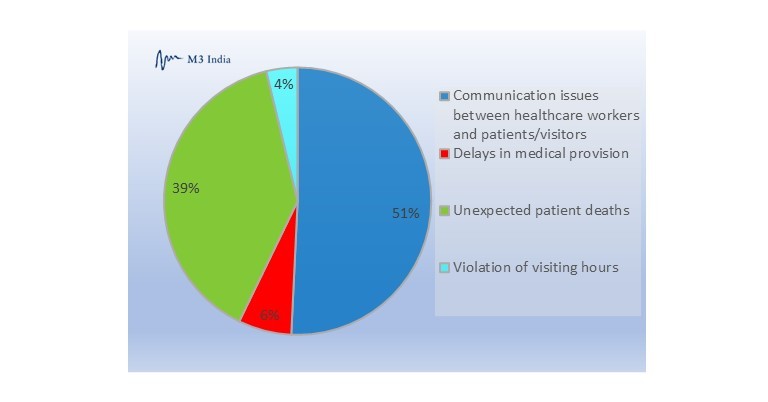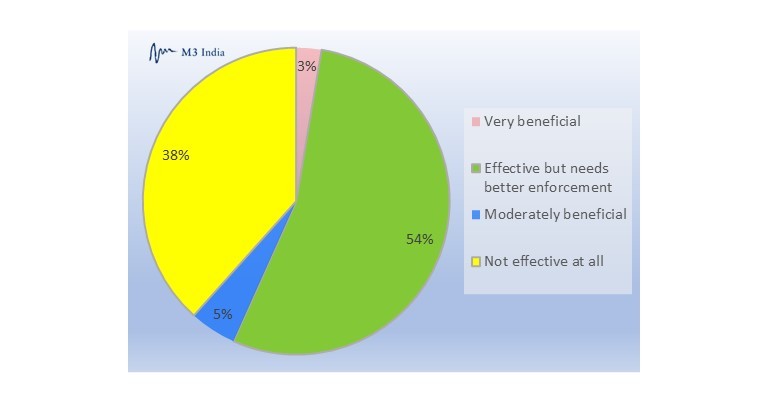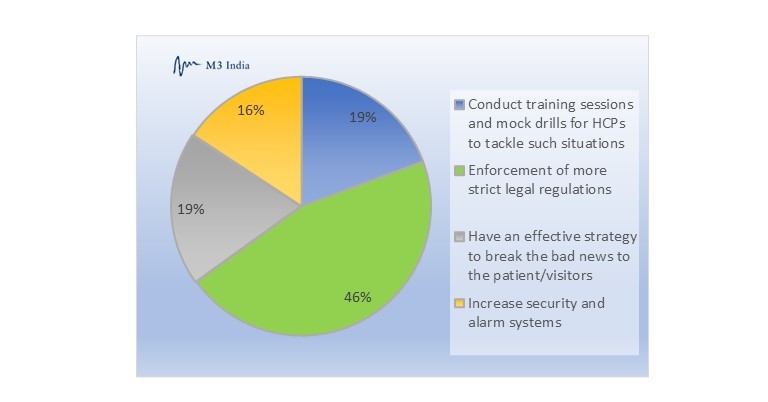Violence Against Healthcare Personnel: Effective Strategies to Curb This
M3 India Newsdesk May 04, 2023
The risk of physical assault on healthcare workers is high in many places in the world. M3 India conducted a survey and analysed the current status of safety for HCPs and their opinions about it. This article examines the major causes of violence as well as techniques for dealing with problematic patients and visitors.
To better understand the current situation of violence against medical professionals, M3 India conducted an online survey- Violence against HCPs in which 48% of doctors participated from private hospitals, 37% from government hospitals, and 15% from private practices. The analysis found the following demographic percentage of doctors who encountered violence involving physical assault by a patient or their attenders.

In many parts of the globe, healthcare professionals face a significant danger of physical assault. A number of HCPs experience physical violence throughout their employment. Several others are targets of verbal abuse or threats. Patients and visitors account for the vast majority of violent acts.
Additionally, in times of tragedy or conflict, medical personnel may be the targets of political or group violence. Nurses and other frontline healthcare providers, as well as those working in the ER and ambulance services, are among the most vulnerable in the healthcare industry.
Aggression towards medical personnel is just wrong. Healthcare workers' mental and physical health suffers and their desire to do their jobs suffers as a result. As a result, the safety and efficacy of health services are compromised by this violence. It causes huge losses in the healthcare industry as well according to WHO.
Workplace violence in the health sector includes any incident in which a healthcare worker is abused, threatened, or assaulted in circumstances related to work (including travelling to and from work) and which poses an explicit or implicit challenge to the worker's safety and wellbeing. The negative consequences spread like a wave.
-WHO
In India, there is a rising and persistent issue of violence against medical staff. During the last decade, healthcare professionals have been subjected to increasing levels of violence in India. In spite of this, violence has escalated in India as a result of the COVID-19 outbreak, making the country one of the most hostile for medical professionals. According to the Protecting Health in Conflict Coalition, the number of assaults on healthcare professionals in India has skyrocketed from 49 in 2017 to 155 in 2020.
Junior physicians and nurses at public hospitals are more in danger, but all healthcare employees are four times more likely to be assaulted than other professionals in the workplace. It seems that early-morning outpatient shifts and late-night shifts pose the greatest danger to healthcare professionals, as do shifts in the emergency department, critical care unit, or other secluded areas.
Key contributors to violence against healthcare workers include:
- Communication issues between healthcare workers and patients and visitors (The most prominent cause of attack as per the survey conducted on M3 India)
- Discontent with care
- Delays in medical provision
- Violations of visiting hours
- The mental stress of a patient's family
- Denial of hospital admission
- Unexpected patient deaths
Most prominent causes of attacks on HCPs as per the survey conducted on M3 India

Strategies to effectively handle violent patients and high-risk visitors
The centre of interventions to reduce violence against health professionals in non-emergency situations
- The safety of medical institutions is prioritised in emergency intervention plans. In order to fully assess the efficacy of these programs, especially in low-resource areas, further research is required.
- Governments should establish and enforce stringent legislative remedies to tackle this rising danger to the safety of healthcare personnel.
- Governments should take action, such as passing federal legislation or strengthening the enforcement of current state laws, to provide justice for healthcare professionals who have been assaulted or abused while on the job.
1. Standardised procedures
Hospitals may take measures to protect their employees. Standardised procedures for dealing with violent occurrences in hospitals should be implemented.
Violence against healthcare workers can be reduced through a variety of interventions:
- Graphical representations discouraging violence
- Alarm systems
- Increased security
- A strict ban on weapons
- Grievance cells to lodge disputes
- Restricting the number of visitors
- Counselling for families who lost loved ones
2. Mock drills
Train healthcare workers to take proactive actions, such as notifying security, in an escalating situation.
3. Policies of zero tolerance for violence
The research suggests that hospitals may reduce their rates of violence if they are given detailed information about their institution's history of violence, which can then be used to develop more effective action plans for violence prevention. Someone at the hospital should be in charge of handling media inquiries regarding such events. Policies of zero tolerance for violence, outlining what is not tolerated and the repercussions for acting otherwise, should also be in place.
4. Reports in the media
A balanced, as opposed to a sensationalised, representation of healthcare workers' jobs is provided by the media, which also plays a role in influencing public perception of these professionals. Reports in the media are a vital source of information for tracking incidents of violence against India's healthcare professionals; as such, they need careful documentation. It is the duty of the media to promote knowledge of legal repercussions and speak out in favour of the life of healthcare personnel.
5. Speak out against acts of violence
Everyone has an obligation to speak out against acts of violence committed against those in the healthcare industry. To address this systemic issue, public stewardship in the form of action, lobbying, and support for healthcare employees is essential. Awareness campaigns, bridge-building between communities and healthcare providers, and mobilisation of the public to demand legal action from the government may all be accomplished via the efforts of NGOs and civil society.
Representation of how doctors perceive the existing legal protections to protect doctors and healthcare workers as per the survey conducted on M3 India
6. De-escalation techniques
On an individual level, healthcare personnel need training in safety and recognising early indications of violence to better manage or avoid situations that develop confrontationally. Medical personnel may lessen the severity of the effects of violent occurrences by learning de-escalation techniques. In the event of an outbreak of violence, however, social media organisations made up of medical personnel may be utilised to disseminate urgent messages. Misunderstandings are another common source of conflict, although they may be mitigated by patient participation in decision-making and better professional training in breaking bad news to patients and their families.
Eleven recommendations for improving the safety of medical staff in hospitals were made by the Kerala Medical Post Graduate Association (KMPGA) in a letter to Kerala's health minister. The deployment of police stations staffed by sufficient numbers of officers and connected to the hospital's intercom system is one such measure.
7. Bad news breaking protocol
- Having a 'Bad News Breaking Protocol,' as well as console rooms in the ICU where the prognosis and death of the patient may be communicated in a secure atmosphere with CCTV surveillance.
- An emergency code to signal danger perception to hospital employees.
- A dedicated team which can react instantly.
- Display boards promoting awareness of the Hospital Protection Act and pertinent portions of the Code of Criminal Procedure.
- Addressing staff shortages, and efforts to prevent future incidents are also recommended.
When asked how safe they felt in their current workplace, doctors reported that 55% felt safe, 39% felt very unsafe, and 7% of them felt very safe. As per the responses, 46% of doctors think that the best way to handle a violent situation would be to enforce more strict legal regulations.

A societal issue of this magnitude demands multi-pronged approaches to addressing violence against healthcare personnel. Violence has the potential to spark widespread dissatisfaction among healthcare employees, which might disrupt the healthcare system and negatively impact patient care.
It is time to encourage hospital managers, policymakers, and legislators to act on this issue, given the spike in violence during the COVID-19 outbreak and the broad acknowledgement of the crucial social role of our healthcare personnel. Every member of a law-abiding society has an obligation to contribute to healthcare workers' safety.
Disclaimer- The views and opinions expressed in this article are those of the author and do not necessarily reflect the official policy or position of M3 India.
About the author of this article: Dr Monish Raut is a practising super specialist from New Delhi.
-
Exclusive Write-ups & Webinars by KOLs
-
Daily Quiz by specialty
-
Paid Market Research Surveys
-
Case discussions, News & Journals' summaries